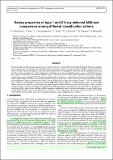Por favor, use este identificador para citar o enlazar a este item:
http://hdl.handle.net/10261/260193COMPARTIR / EXPORTAR:
 SHARE SHARE
 CORE
BASE CORE
BASE
|
|
| Visualizar otros formatos: MARC | Dublin Core | RDF | ORE | MODS | METS | DIDL | DATACITE | |

| Título: | Galaxy properties of type 1 and 2 X-ray selected AGN and a comparison among different classification criteria |
Autor: | Mountrichas, George CSIC ORCID; Buat, Véronique; Georgantopoulos, Ioannis; Yang, Guang; Masoura, V. A. CSIC ORCID; Boquien, Médéric; Burgarella, Denis | Fecha de publicación: | 2021 | Editor: | EDP Sciences | Citación: | Astronomy and Astrophysics 653: A70 (2021) | Resumen: | We present analyses of host galaxy properties of type 1 and type 2 X-ray selected Active galactic nuclei (AGNs) in the XMM-XXL field, which have an available optical spectroscopic classification. We modelled their optical to far-infrared spectral energy distributions (SEDs) using the X-CIGALE code. X-CIGALE allows for the fitting of X-ray flux and accounts for the viewing angle of dusty torus and the attenuation from polar dust. By selecting matched type 1 and 2 sub-samples in the X-ray luminosity and redshift parameter space, we find that both types live in galaxies with similar star formation. However, type 2 AGN tend to reside in more massive systems (10.87−0.12+0.06 M⊙) compared to their type 1 counterparts (10.57−0.12+0.20 M⊙). In the second part of our analysis, we compare the spectroscopic classification with that from the SED fitting. X-CIGALE successfully identifies all spectroscopic type 2 sources either by estimating an inclination angle that corresponds to edge on viewing of the source or by measuring increased polar dust in these systems. Approximately 85% of spectroscopic type 1 AGN are also identified as such, based on the SED fitting analysis. There is a small number of sources (∼15% of the sample) that present broad lines in their spectra, but they show strong indications of obscuration, based on SED analysis. These could be systems that are viewed face on and have an extended dust component along the polar direction. The performance of X-CIGALE in classifying AGN is similar at low and high redshifts, under the condition that there is sufficient photometric coverage. Finally, the usage of optical/mid-IR colour criteria to identify optical red AGN (u − W3) suggests that these criteria are better suited for IR selected AGN and their efficiency drops for the low to moderate luminosity sources included in X-ray samples. | Descripción: | arXiv:2106.11579v1 | Versión del editor: | https://doi.org/10.1051/0004-6361/202141273 | URI: | http://hdl.handle.net/10261/260193 | DOI: | 10.1051/0004-6361/202141273 | E-ISSN: | 1432-0746 |
| Aparece en las colecciones: | (IFCA) Artículos |
Ficheros en este ítem:
| Fichero | Descripción | Tamaño | Formato | |
|---|---|---|---|---|
| galaxcriter.pdf | 1,64 MB | Adobe PDF |  Visualizar/Abrir |
CORE Recommender
SCOPUSTM
Citations
20
checked on 16-may-2024
WEB OF SCIENCETM
Citations
20
checked on 27-feb-2024
Page view(s)
31
checked on 21-may-2024
Download(s)
36
checked on 21-may-2024
Google ScholarTM
Check
Altmetric
Altmetric
NOTA: Los ítems de Digital.CSIC están protegidos por copyright, con todos los derechos reservados, a menos que se indique lo contrario.
